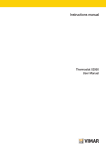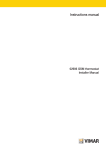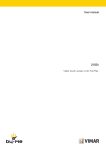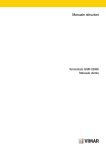Download Instructions manual
Transcript
Instructions manual 02906 GSM thermostat User Manual Table of Contents 1. GSM thermostat 02906……………………………………………………………………………………………… 2 2. GSM function………………………………………………………………………………………………………… 2 2.1 Fitting and replacing the SIM card……………………………………………………………………………… 2 3. Display………………………………………………………………………………………………………………… 4 3.1 Functions of the buttons ………………………………………………………………………………………… 3.2 Symbols…………………………………………………………………………………………………………… 3.3 Ecometer………………………………………………………………………………………………………… 3.4 Locking the interface via PIN…………………………………………………………………………………… 5 5 6 6 4. Operating mode……………………………………………………………………………………………………… 7 4.1 Switched off (OFF) ……………………………………………………………………………………………… 7 4.2 Manual…………………………………………………………………………………………………………… 8 4.3 Away……………………………………………………………………………………………………………… 9 4.4 Nighttime reduction…………………………………………………………………………………………… 10 4.5 Antifreeze……………………………………………………………………………………………………… 11 5. Settings menu……………………………………………………………………………………………………… 12 5.1 Operating mode setting……………………………………………………………………………………… 12 5.2 Heating/air-conditioning setting……………………………………………………………………………… 13 5.3 Temperature set point setting………………………………………………………………………………… 13 5.4 Unit of measurement setting………………………………………………………………………………… 13 5.5 Calibration setting……………………………………………………………………………………………… 13 5.6 External probe setting………………………………………………………………………………………… 13 5.7 OnOff/PID setting……………………………………………………………………………………………… 13 5.8 Buzzer setting………………………………………………………………………………………………… 13 5.9 Standby brightness level setting……………………………………………………………………………… 13 5.10 GSM settings…………………………………………………………………………………………………… 14 5.11 Info……………………………………………………………………………………………………………… 14 5.12 Lock/unlock PIN setting……………………………………………………………………………………… 14 6. Cleaning the device………………………………………………………………………………………………… 14 7. Installation rules……………………………………………………………………………………………………… 14 8. Regulatory compliance…………………………………………………………………………………………… 14 1 1. 02906 GSM thermostat This device is designed to control room temperature by acting on the control circuit of the burner or circulation pump (heating) or on the control circuit of the air conditioner (air conditioning), ensuring an ideal temperature. The graphical user interface, thanks to special views, facilitates system management helping the user to operate while maintaining a state of energy saving. The thermostat has a GSM communicator for remote control, making it ideal for installation in second homes. 2. GSM function By sending and receiving SMSs with the appropriate encryption, the thermostat can be switched on, off and queried for viewing data on the room and it can perform various other functions; interaction with the device for remote control is via the By-clima smartphone app that automatically creates the encrypted SMSs. Using these features you can then: • Set the operating parameters of the thermostat. • Send commands. • Query the thermostat to know the current operating status. • Receive previously configured and enabled alarm notifications. • Receive from the thermostat any SMSs that have not been recognized as command SMSs. Command and monitoring SMSs are generated by the By-clima App while voice calls, reading and therefore interpreting incoming SMSs must be managed manually by the user with the standard smartphone functions. More in detail, the functions associated with GSM mode via SMS or via voice calls are: • Thermostat management = setting the operating mode (Off, Antifreeze, Away, Manual, Nighttime reduction). • Thermostat configuration = programming all the temperature control parameters that can also be set locally by the thermostat and configuration of all the functions of the GSM module that instead cannot be programmed locally. • Requesting the current operating status of the thermostat (for all the various types). • Notification of alarms for power supply voltage failure/restoration (only if configured and paired with users saved in the contacts list). • Notification of technical alarms for exceeding the temperature thresholds (only if configured, enabled and paired with users saved in the contacts list). • Receiving SMSs sent by the thermostat as they are not recognized as being in compliance with the communication protocol (only if configured and paired with users saved in the contacts list). Generally, the configuration commands do not require confirmation SMSs as instead is the case for the monitoring commands; so, in order to have confirmation on successfully setting a parameter, you need to query the thermostat about its status. Otherwise, all the command operations that, for example, change the active temperature control mode, will generate an SMS for notification and confirmation of the operation. Using the "phone call" function, which generates a voice call from a recorded user, you can obtain information on the general status of the device. Associated to the voice call, you can also switch the operating state, in the following way: • In heating mode: - from Manual to Antifreeze - from any other mode to Manual • In air-conditioning mode: - from Manual to OFF - from any other mode to Manual Also in this case a report of the general status of the GSM device is sent to the caller number. 2 2.1 Fitting and replacing the SIM card The thermostat can be used with a traditional SIM card (ID-000 format) for voice / SMS traffic; data SIMs cannot be used for operating the device . To install the SIM card: • Disable the PIN code from the SIM card (install the SIM in a mobile phone and when switching on disable the PIN code prompt). • Turn off the power supply to the thermostat 02906. • Remove the front panel by inserting a screwdriver into the slot in the bottom and pushing the release tab upwards and, at the same time, pull out the front of the product. • Insert the SIM card into the SIM holder in the rear of the front panel you have just removed. • Fit the front panel back into its original position by hooking it onto the mounting tabs located on the upper side of the part on the wall and then closing the lower part. Finally, power up the thermostat. 1 2 3 EN OP CK LO 4 5 EN OP CK LO 3 • The icon will show the correct installation and the quality of the GSM network: blinking: switch-on phase (if the icon is still flashing after a few minutes, it means that there is an ERROR so it is necessary to check the SIM card) : GSM signal not present or insufficient : GSM signal barely sufficient (up to 20%) : GSM signal from 20% up to 50% : GSM signal from 50% up to 80% : optimum GSM signal (over 80%) 3. Display The touchscreen display allows you to control the system using the following buttons and icons: A B L I H G F E Fig. 1: Graphical interface and buttons A: GSM network signal B: Operating mode C: Away D: Confirm E-F: Menu navigation and setting parameters G: Back H: Nighttime reduction I: Settings menu L: Ring indicating consumption level and energy savings indicator 4 D C 3.1 Functions of the buttons : increases the numerical values. When it "disappears" from the display it means that the value cannot be increased any more. : decreases the numerical values. When it "disappears" from the display it means that the value cannot be decreased any more. : during navigation, it scrolls through the available menus to the right. If it "disappears" then you have arrived at the last of the items that can be scrolled. : during navigation, it scrolls through the available menus to the left. If it "disappears" then you have arrived at the last of the elements that can be scrolled. : confirms the selected option (activates the submenu if there is one or displays the next parameter/digit). After each confirmation, the display shows the icon for approximately 1 s. : back (or cancel) exits the current screen/menu and returns to the previous one without saving any changes. In menus with changes to multiple digits it lets you go back to change the previous digit. N.B. The field/value being edited is highlighted by the field/value itself flashing. 3.2Symbols Depending on the different operating modes, the following icons could also be displayed: : GSM network signal status : Calibration : Away : Manual (ON) : Nighttime reduction : Antifreeze : Switched off (OFF) : Air conditioning : Heating : Confirm : Eco (saving) 5 3.3Ecometer Energy saving indicator Ring for the level of consumption Fig. 2: Set of ECOMETER icons On the left-hand side of the display there is a set of icons called the "ECOMETER" that provide an overview of the expected consumption as an aid to energy saving. The information displayed is based on a consumption forecast obtained by comparing the currently set temperature setpoint and the estimated average consumption (which therefore has nothing to do with the current room temperature). • The consumption level ring graphically indicates the expected level of consumption. If this level is less than half, it means that there will be a saving compared to the conventional average consumption; vice versa, if the level exceeds half, the expected consumption will be higher than the conventional average. • The energy saving indicator indicates whether the currently set setpoint will allow obtaining savings with respect to the conventional average consumption. 3.4 Locking the interface via PIN The thermostat lets you set a password (see par. 5.12) which inhibits any change to the operating mode (eg switching from Manual to OFF), limits setting the temperature values and, more generally, blocks access to the configuration menu. This feature is useful to prevent the thermostat being used by unauthorized persons: the device prompts you to enter the PIN. Fig. 3: Locking with PIN 6 4. Operating mode The thermostat 02906 is able to adjust the temperature according to the following operating modes: • Switched off (OFF): switches the system off without making any adjustments • Manual (ON): lets you set the required temperature set-point manually • Away: is a mode that lets you set the set-point in order to achieve significant energy savings during periods when the user is away •N ighttime reduction: this mode, which can be activated locally, is useful for changing the manual adjustment set point in the hours of nighttime operation. • Antifreeze: used to set a minimum temperature level to avoid damage to pipework or prevent the temperature from falling below a safety level. The operating mode is selected via the SETTINGS menu (see chap. 4). 4.1 Switched off (OFF) With this mode on, the thermostat is turned off and you cannot make any adjustments; in this case, the icon is displayed above the temperature indicator. When the thermostat is OFF, you cannot perform any operations other than accessing the configuration menu. Fig. 4: Typical screen for OFF mode For heating-only systems this mode is typically used in the summer. 7 4.2 Manual (ON) This is the "traditional" operating mode. The thermostat controls the room temperature and takes it to the value set by the user (manual adjustment setpoint). Fig. 5: Typical screen for Manual mode The set point can always be changed via or . In the course of setting, the set point flashes and the circular ring fills up accordingly; this gives an indication of the expected consumption as a function of the set point you are setting: Fig. 6: Manual set point setting The selection is confirmed by touching . The and icons in the lower right corner indicate whether the system is operating in heating or air-conditioning mode respectively (icon illuminated = system on). 8 4.3Away This mode is useful to achieve energy savings quickly and effectively whenever the user leaves the regulated room. In "Away" mode the system makes the adjustment according to the "away temperature" setpoint . The Away mode can only be activated in manual mode by touching . The display will show the "away temperature" setpoint for approximately 2 seconds: Fig. 7: Input in away mode showing the away temperature Activation of this mode is identified by the icon above the temperature indicator: Fig. 8: Away Mode To exit and return to Manual mode touch the button again. 9 4.4 Nighttime reduction This is the typical mode to use at night to reduce system consumption significantly. In "Nighttime reduction" mode the device reduces the consumption of the system, taking the room temperature to a lower value (or higher, if on air-conditioning) than the Manual mode by degrees. The "Nighttime reduction" function is done from Manual mode by touching or remotely. The display will show the "nighttime reduction" setpoint for approximately 2 seconds: Fig. 9: Input in Nighttime Reduction mode showing the reduction set point Activation of this mode is identified by the icon above the temperature indicator: Fig. 10: Nighttime reduction mode To exit and return to Manual mode touch 10 again. 4.5Antifreeze This mode, which can only be activated when the system is operating in heating mode, lets you set a minimum temperature value ( setpoint) to avoid damage to the pipework or to keep it from falling below a certain safety level when you are away for lengthy periods in the winter. The "antifreeze" mode is activated directly from the Settings menu (see par. 5.1). Once activated, antifreeze mode is identified by the icon above the temperature indicator. Fig. 11: Antifreeze mode 11 5. Settings menu From the settings menu you can configure all the features of the thermostat. On the main screen (see Fig. 1) tap the icon. From the main menu, using and will display the following (flashing) symbols in succession, which provide access to the corresponding submenus: 1. operating mode setting 2. and 3. air-conditioning/heating setting temperature setpoint setting 4. unit of measurement setting 5. calibration setting 6. external temperature probe setting (shown only when the probe is connected) 7. OnOff/PID temperature control algorithm setting 8. 9. buzzer setting brightness of the display on Standby setting 10. GSM function setting 11. device info 12. lock/unlock PIN setting Touching opens the submenu and then the flashing highlights the parameters of the submenu. 5.1 Operating mode setting This menu is used to select the operating mode of the device: • Manual • • Using 12 Off Antifreeze (only if the thermostat is set on "heating") and select the required mode and confirm with . 5.2 Heating/air-conditioning setting This menu is for the sole use of the installer. 5.3 Temperature set point setting This menu is for the sole use of the installer. 5.4 Unit of measurement setting • The menu lets you set the unit of measurement used for the temperature (°C or °F) Using and select the required unit of measurement and confirm with . 5.5 Calibration setting This menu is for the sole use of the installer. 5.6 External probe setting This menu is for the sole use of the installer. 5.7 OnOff/PID setting This menu is for the sole use of the installer. 5.8 Buzzer setting This menu lets you enable/disable the acoustic signals of the thermostat; if it is disabled there will no longer be any sound when you touch the buttons or in cases of confirmation/error. Whereas, in the event of an alarm, the sound signal will always be guaranteed. Using and select “ON” or “OFF” and confirm with . 5.9 Standby brightness level setting The menu lets you set the brightness level when the thermostat is in standby mode. Using or you can select one of the folloiwng levels with gradually increasing brightness: •OFF • 1, 2, 3, 4, 5, 6, 7 While scrolling through the values, when the selection stops on a certain level, the brightness of the display will, for approximately 2 s, take on the brightness corresponding to the selected level in order to allow the user to check the visual effect. Finally, tap to confirm your choice. 13 5.10 GSM settings All the GSM functions are set exclusively via a special smartphone App which communicates by SMS with the thermostat and not via the actual thermostat; the latter is used to enable all the functions described in paragraphs 5.10.1 and 5.10.2. 5.10.1 Switching on/off the GSM radio This option is used to switch the GSM radio transmitter on of off (for example, to check that the thermostat is set only locally and that it cannot be remotely enabled/modified by any other configured mobile phone). Using and select “ON” or “OFF” and confirm with . 5.10.2 GSM parameter resetting This menu is for the sole use of the installer. 5.11 Info This menu is for the sole use of the installer. 5.12 Lock/unlock PIN setting This menu lets you add/change the password to inhibit use of the thermostat. Using or each set digit. you can set the three digits of the PIN one at a time and then confirm N.B. Having set the PIN return to the main menu; the PIN is active after around 30 s. If you wish to have free access to the thermostat (so without it prompting you for a password) it is sufficient to set the PIN to "000". IMPORTANT: Take care to note down the password so that you can use it again for the device when needed. 6. Cleaning the device The device features a touchscreen display with capacitive buttons and therefore requires you to be gentle during the cleaning phase. Avoid using aggressive products. Clean the display with a special cloth for cleaning lenses. 7. Installation rules Installation should be carried out in compliance with the current regulations regarding the installation of electrical systems in the country where the products are installed. 8. Standard compliance LV directive. EMC directive. Standards EN 60730-2-9. 14 15 Viale Vicenza, 14 - 36063 Marostica VI - Italy Tel. +39 0424 488 600 - Fax (Italy) +39 0424 488 188 Fax (Export) +39 0424 488 709 www.vimar.com 02906 user 01 1407 VIMAR - Marostica - Italy

























